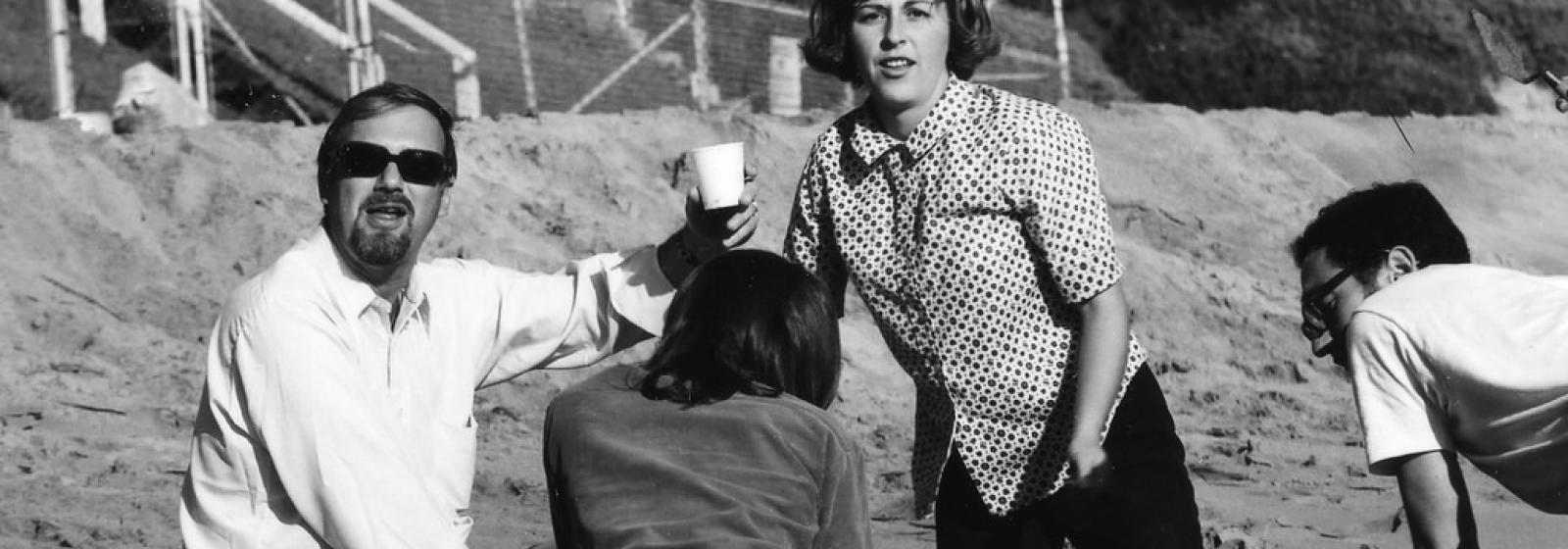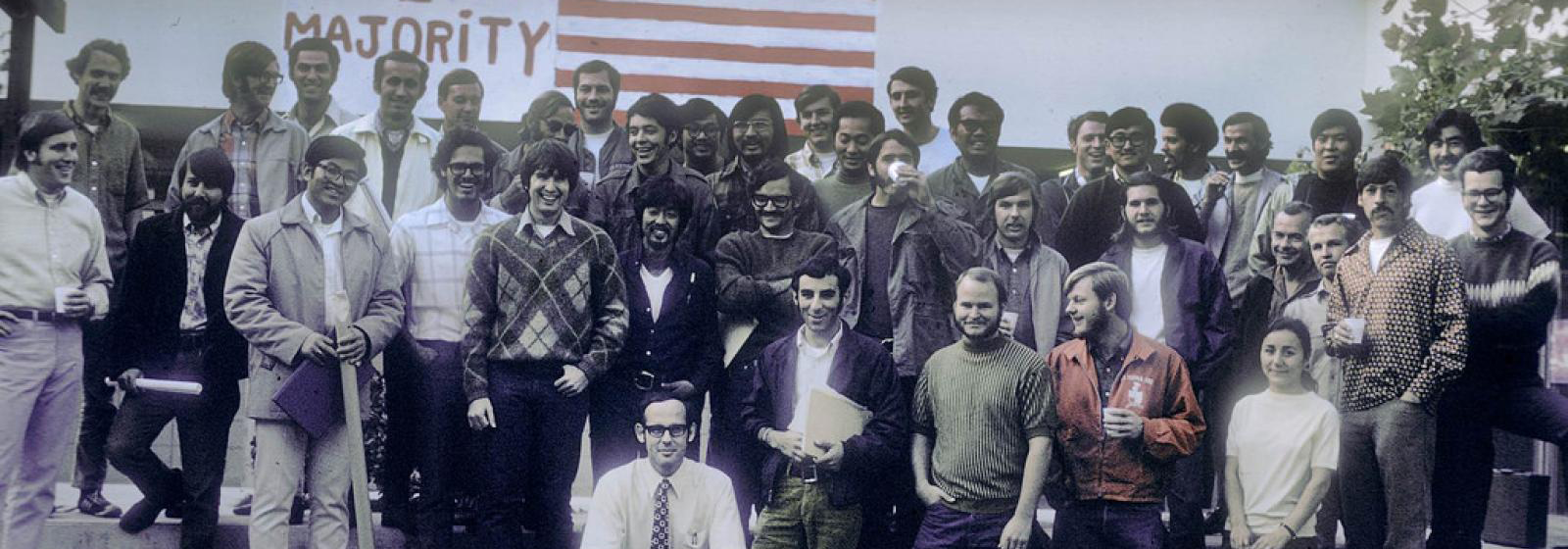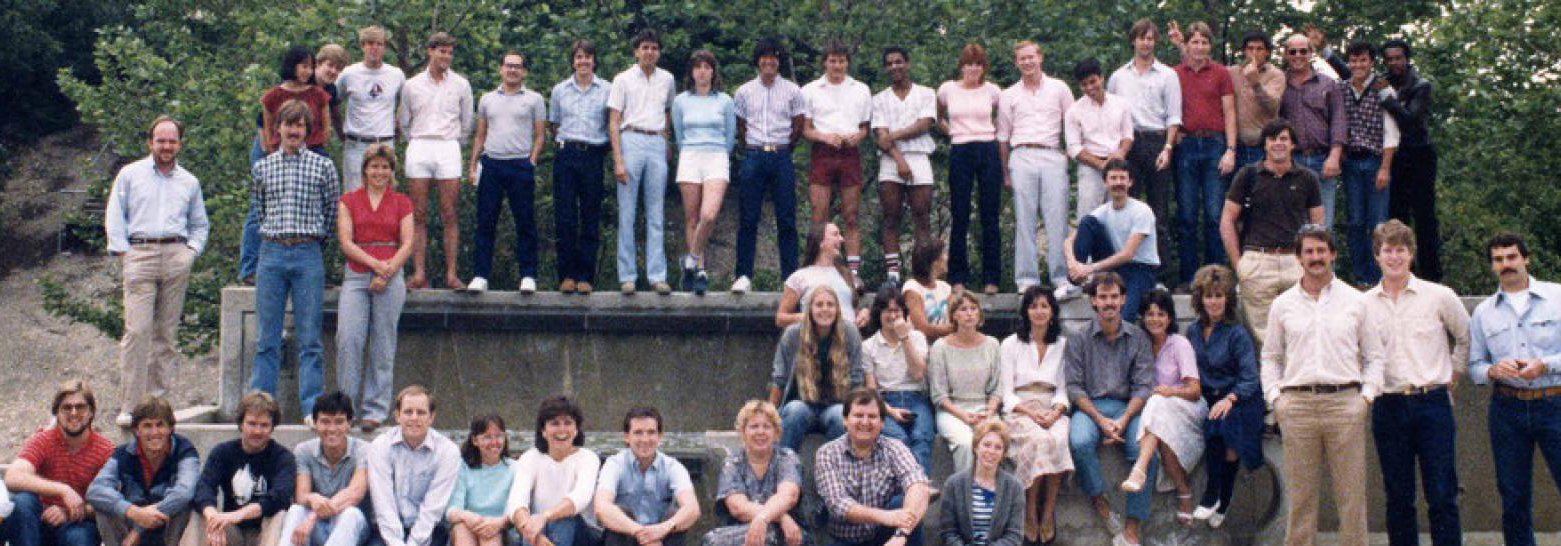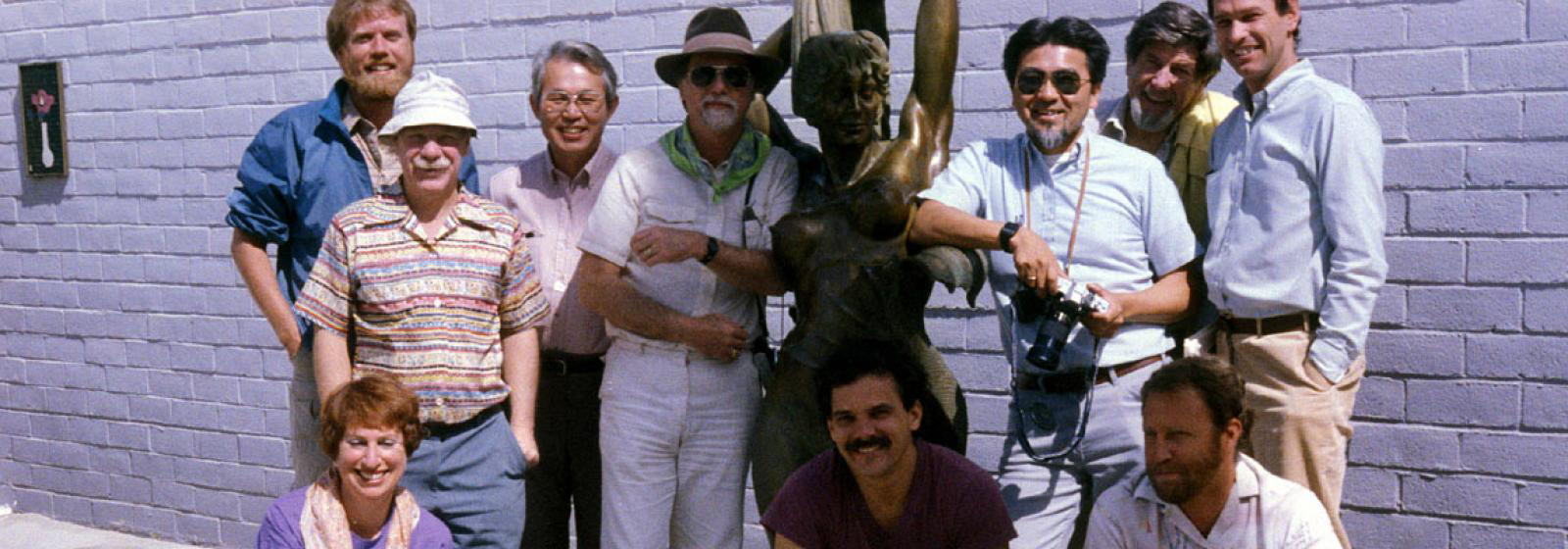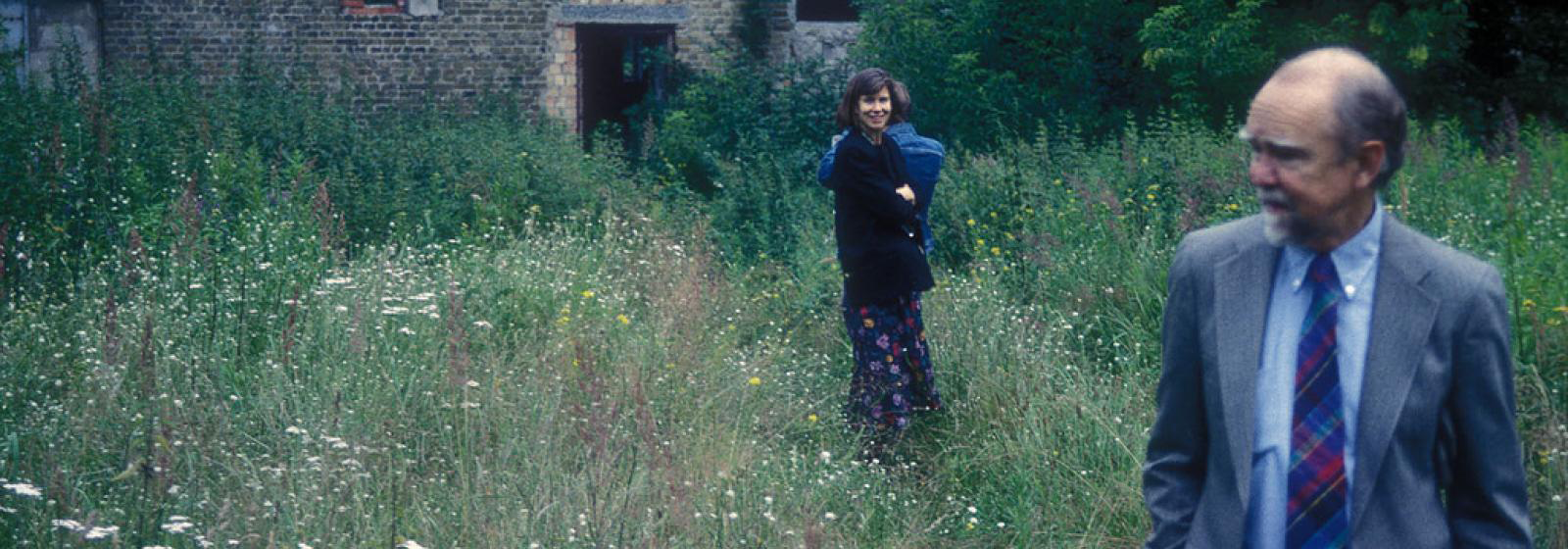Department History
1938
The 157-acre Voorhis School for Boys near San Dimas becomes the Southern campus of California State Polytechnic School of San Luis Obispo, after being donated by Charles B. Voorhis and his son, Congressman Jerry Voorhis. Enrollment is approximately 300 - all male. Dr. Julian A. McPhee served as president of the joint campuses until his retirement in 1966.
1945
The parent institution is renamed California State Polytechnic College.
1949
The cereal magnate, W. K. Kellogg, deeds his 813-acre Arabian Horse Ranch near Pomona to the State.
1953
The first courses in landscape architecture at Cal Poly, Pomona are offered under the direction of the Ornamental Horticulture Department.
1956
The former Kellogg Ranch becomes the second campus of the college's southern facility. Formal classes begin with an all male enrollment of 550 students with the college offering six programs in agriculture leading to four Bachelor of Science degrees.
1957
The major of Landscape Architecture is established in the School of Agriculture with Professor Howard Owen Boltz as coordinator and a full-time faculty of three.
1959
Recognition of the program is granted by the California Board of Landscape Architects. The curriculum of the college now includes six degree programs in the arts and sciences and four in engineering.
1961
The implementation of the State Master Plan for Higher Education establishes the California State University and College system under the direction of its own Board of Trustees. The program in Landscape Architecture is elevated to departmental status with Professor Boltz as chairman.
1962
The college enrollment has now become coeducational and the Voorhis Campus is converted to use as a continuing education center and a laboratory for students in agriculture and natural science.
1963
Professional accreditation is granted by the American Society of Landscape Architects and the Department of Landscape Architecture is renamed the Department of Environmental Design (with the addition of a major in Urban Planning).
1966
The Kellogg campus becomes California State Polytechnic College, Kellogg - Voorhis, Pomona, an independent State College within the State University and College system. The independent status is accompanied by the appointment of Dr. Robert C. Kramer as president.
1967
The department is elevated to the status of Division of Environmental Design with programs in Landscape Architecture and Urban Planning under the direction of Howard Owen Boltz. Jere Stuart French is appointed coordinator of the Landscape Architecture program. Professional accreditation is renewed and following the death of Professor Boltz in 1968, Professor French becomes director of the Division of Environmental Design with Professor Chester Volski appointed to coordinator of the Landscape Architecture program.
1969
The School of Environmental Design is established with departments of Landscape Architecture, Urban Planning, and a new Department of Architecture. William Dale is appointed Dean with Professor French appointed as chairman of the Department of Landscape Architecture.
1970
The Environmental Design building is occupied, doubling the existing classroom and studio space. The graduate program in Landscape Architecture, with a strong orientation toward ecosystematic design, is initiated under the direction of Professor John T. Lyle. Cal Poly Pomona receives accreditation from the Western Association of Schools and Colleges.
1971
Dr. H. Frederick Koeper is appointed Dean of the School of Environmental Design with Cameron R. J. Man succeeding Professor French as chairman of the Department of Landscape Architecture. Kellogg West, the center for Continuing Education, a complex made possible by a $3 million grant from the W. K. Kellogg Foundation, opens and becomes the first such facility within a state-wide system of higher education.
1972
On June 1, 1972 Cal Poly, Pomona is elevated to university status as testimony of its contributions to the academic and professional world.
1975
The department is reaccredited by the American Society of Landscape Architects. Professor Jere Stuart French becomes chairman of the department. Between 1957 and 1975 the department faculty grows from three to thirteen and a number of specialties and innovations were introduced, taking advantage of various faculty expertise and interests. Special concern for graphic communication and construction techniques were devised, a new method for teaching landscape history was developed and specific directions in fourth year design were developed in order to recognize differing areas of professional development. The Resource Collection, which was originally established in 1971, had been enlarged by 1975 to include a slide collection, periodicals, scholarly reports and theses, and professional publications.
1978
Dr. Hugh O. La Bounty, Jr. is inaugurated as University President on October 31, 1978.
1979
In 1979 Chairman French is appointed Dean of the School of Environmental Design and Professor John T. Lyle is appointed chairman of the Department of Landscape Architecture. Professor Jeffrey K. Olson is appointed coordinator of the graduate program.
1980
The undergraduate program is reaccredited and the graduate program receives its first provisional accreditation from the Landscape Architectural Accreditation Board.
1982
Dean French resigns, and Professor Marvin Malecha is appointed Dean of the School of Environmental Design.
1983
Professors Lyle and Olson participate in the planning of Landlab, the university's new laboratory for education and research in the sustainable use of resources. This will be an important resource for the department.
1985
The BSLA program is reaccredited and the MLA program is granted full accreditation by the Landscape Architecture Accreditation Board.
1987
Plans are completed for the Institute for Regenerative Studies which will offer additional support for the department's programs. The Kellogg Foundation provides a $1.5 million grant to establishment of the Center for Regenerative Studies based on the work of John T. Lyle and others from the Department of Landscape Architecture and University. On the basis of this grant the University was able to proceed in obtaining the rest of the funds to build first phases of the Center.
1988
School of Environmental Design becomes the College of Environmental Design. Landscape Architecture faculty participate with interdisciplinary teams to begin teaching experimental classes in regenerative studies under the CPU designation.
1989
Since 1956, the educational programs have grown from six undergraduate programs enrolling 550 men to 56 undergraduate and 15 graduate programs and nine teaching credential programs, enrolling close to 20,000 men and women. The number of degrees granted increased from 54 in June 1957 to over 2,750 in June 1989. Professor John Lyle steps down from the Department Chair position and Professor Kenneth Nakaba is appointed Acting Chair.
1990
The undergraduate and graduate programs are reaccredited by the LAAB. Professor Kenneth Nakaba is appointed Chair. With Professor Takeo Uesugi, Ph.D. as coordinator, Cal Poly Pomona and the Kyushu Institute of Design enter into a Faculty and Student Exchange Agreement.
1992
The Department of Art joins the College of Environmental Design, offering additional opportunities for closer collaboration and use of facilities. Associate Professor Joan Safford is appointed Graduate Program Coordinator. Dr. Bob H. Suzuki is formally inaugurated as the new University President on April 29, 1992.
1993
The Center for Regenerative Studies opened establishing demonstrations of renewable energy systems, intensive agriculture and aquaculture, as well as offices, class rooms, a commons and living accommodations for 30 resident students. Professor John Lyle serves as Acting Director for the Center and welcomes the first group of students to the newly opened facilities after two years of construction. The first group of senior students, led by Lecturer Phil Pregill, spends Fall Quarter at the Santa Chiara Study Center at Castiglion Fiorentino, Italy. In collaboration with the four departments, the College of Environmental Design initiates the ENV core, a jointly taught interdisciplinary series of courses for all first year Environmental Design students. The courses are ENV 101 and 102 (Introduction to Environmental Design); ENV 115 and 116 (History of Environmental Design); and ENV 120 (Introduction to Computers).
1994
Dean Malecha resigns, and Professor Spryos Amourgis is appointed Interim Dean of the College of Environmental Design.
1995
The undergraduate and graduate programs are reaccredited by the LAAB.
1996
Dr. Peter Dual is appointed Academic Vice President, July 1. Linda Sanders is appointed Dean of the College of Environmental Design. The Department hosts International Symposium on Regenerative Design and Sustainable Development, at the Center for Regenerative Studies.
1998
The College of Environmental Design reassumes management and control of the Center for Regenerative Studies. Professor Joan Safford is named Acting Director of the Center for Regenerative Studies. Associate Professor Joan Woodward is appointed Graduate Program Coordinator.
1999
The Center for Regenerative Studies is renamed the John T. Lyle Center for Regenerative Studies in honor of Professor Lyle. Dr. Peter Dual resigns as Academic Vice President, and Dr. Richard Santillan is named Interim Academic Vice President.
2000
Dr. Jane Ollenburger is appointed as Academic Vice President. The undergraduate and graduate programs are reaccredited by the LAAB. Professor Kenneth Nakaba, FASLA steps down from Department Chair position and Associate Professor Philip N. Pregill is appointed to serve as Department Chair. Dr. Takeo Uesugi retires from the Department faculty, but continues to teach one quarter per year through the University's early retirement program.
2001
Assistant Professor Jerry Taylor joins the tenure-track faculty. Professor Jeff Olson retires from the Department faculty. Professor Mark von Wodtke retires from the Department faculty, but continues to teach one quarter per year through the University's early retirement program. Professor Joan Safford resigns as Director of the John T. Lyle Center for Regenerative Studies, and rejoins the Department faculty. The department adopts a Vision, Mission, and Values statement as part of a new strategic plan, focusing on five broad strategies. Department holds first annual "Modules Week" in the spring to allow for vertical integration of students at all academic levels in intensive, one-week courses on specialized topics within the discipline.
2002
Dean Sanders resigns, and Dr. Richard Willson is appointed Interim Dean of the College of Environmental Design. Assistant Professor Ken McCown joins the tenure-track faculty. Objectives in support of the strategic plan are adopted and a faculty teaching interest survey is conducted to help determine teaching gaps relevant to future faculty hiring. Department focus on Regenerating Los Angeles is articulated and explored for curricular, hiring, and research implications.
2003
Dr. Ollenburger resigns, and Dr. Tomas Morales is appointed as Interim Provost and Academic Vice President Dr. Suzuki resigns and Dr. Michael Ortiz is appointed as new University President. Karen Hanna is appointed Dean of the College of Environmental Design.
2004
Dr. Kyle Brown is appointed director of the Lyle Center for Regenerative Studies. Professor Joan Safford rejoins the faculty and the graduate studies committee.
2005
The undergraduate and graduate programs are reaccredited by the laab until 2010. Dr. Jenny Yang joins the tenure-track faculty as assistant professor. Andrew Wilcox joins the tenure-track faculty as assistant professor. Professor D. Rodney Tapp retires and enters the FERP program. Professor Kenneth Nakaba retires and enters the FERP program. Professor Robert Perry retires.
2006
Assistant Professor Jeff Juarez resigns from the faculty. Dr. Jenny Yang resigns from the faculty. Professor Joan Safford resigns from the faculty. Department coordinator Cathy Demarzie retires after 25 years. Lauren Corona appointed as interim department administrative coordinator. The Decision is made to increase graduate enrollment to 20 students per year.
2007
Dr. Susan Mulley joins the tenure-track faculty as assistant professor. Assistant professor Ken Mccown resigns from the tenure-track faculty. Department celebrates its 50th anniversary. Joan Woodward takes an extended leave of absence from the department.
2008
Karen Hanna resigns as dean of the college of environmental design. Dr. Kyle Brown appointed as Interim Dean of the college of environmental design. Professor Phil Pregill steps down as chair of the department of landscape architecture. Associate Professor Gerald O. Taylor appointed as Interim Chair of the Department of Landscape Architecture. Professor Joan Hirschman Woodward takes leave from the Department of Landscape Architecture. Dr. Weimin Li joins the tenure-track faculty as assistant professor. Christopher Artemus Aykanian joins the tenure-track faculty as assistant professor. Jerry Taylor is granted tenure and becomes Associate Professor. Kyle Brown becomes full professor. Chair search initiated but is cancelled due to state budget cuts to education.
2009
Michael Woo appointed as dean of the College of Environmental Design. Professor Karen Hanna rejoins the full-time faculty in landscape architecture. Professor Noel Vernon resigns the position of associate dean and rejoins the full-time faculty in landscape architecture.
2010
Dr. Lee-anne Milburn begins appointment as chair of the Department of Landscape Architecture. Professor Noel Vernon appointed assistant Dean for the college of Environmental Design. Professor Joan Hirschman Woodward resigns from the department. Professor D. Rodney Tapp completes the FERP program and retires. Administrative coordinator Lauren Corona takes a promotion and joins career services as an event coordinator; Kris Penrose from institutional services and the department of architecture accepts the job of administrative coordinator.
2011
Professor Kenneth Nakaba completes FERP program and retires. Assistant Professor Christopher Aykanian resigns from the program. Assistant Professor Andrew Wilcox receives tenure and is promoted to Associate Professor. Berry Lehrman accepts a faculty position as assistant professor with the department and begins teaching, fall quarter 2011. The Landscape Architecture program applies for accreditation with the LAAB. The graduate program receives a six-year accreditation status. The undergraduate program receives a two-year provisional accreditation status.
2012
Rennie Tang accepts a faculty position as assistant professor and commences teaching fall quarter. The Department upgrades the ENV Library databases to include ecology abstracts and dissertations in science and technology. The Italy program conducts its 20th annual session at the Santa Chiara Study Center. Professor Noel Vernon retires from the Department. Assistant Professor Dr. Susan Mulley receives tenure and is promoted to Associate Professor.
2013
The Landscape Architecture applies for accreditation with the LAAB and receives a four-year accreditation.
2014
Department proceeds with semester conversion process. Assistant Professor Dr. Weimin Li receives tenure and is promoted to Associated Professor.
2015
Associate Professor Lee-Anne Milburn is promoted to Full Professor. Professor Karen Hanna retires, spring quarter, 2015. Professor Lee-Anne Milburn steps down as chair of the Department, December 2015. The department submits its semester conversion curriculum to the University for approval.
2016
Associate professor Andrew Wilcox is promoted to full professor. Professor Andrew Wilcox accepts the position as acting chair of the Department of Landscape Architecture, beginning winter quarter, 2016. Professor Wilcox accepts the position of full-time chair in Fall 2016.
